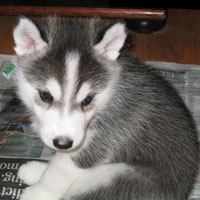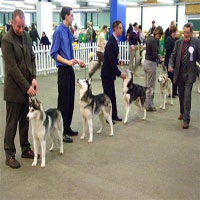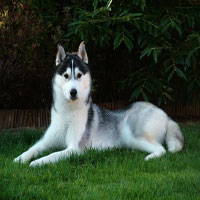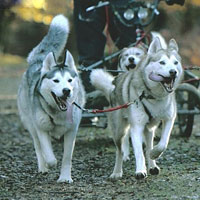 |
Puppies:
• . Never buy a dog from a newspaper/internet advertisement. Recommended breeders only.
• . Don't buy a dog from the 1st person who offers you one. Shop around, visit other breeders. Take your time.
• . When you find a breeder, Go visit them. Do they ask you lots of questions about you, your home life, other animals, children etc? A good breeder will be more concerned with where their dogs are going to than your money.
• . Are the parents KC registered? Does the breeder have breeding rights for the mother? Are the pups registered? If the pups are not registered you will not be able to show or race the pup.
• . Make sure you see one of the Pups parents - usually the Mother. Watch what the mother is like both with you and with the pups. A Siberian Mother can be protective of their offspring, but you shouldn't experience aggression if you are sensible around the puppies.
• . Have the pups been brought up in the house or outside? If outside they may not have had too much human contact and might cause you a problem when you get them home.
Are you getting a pup that is less than 8 weeks old? Weeks 5 - 6 is the most important for a puppy. These are the weeks that the mother teaches a pup social skills - like how not to play so rough and how to behave around others. If you get a pup earlier than the normal 8 weeks you may have problems with the pup. |
 |
Training:
Siberian Huskies can be a challenge. They are an extremely intelligent, energetic, and stubborn breed, and you must be ready for the unexpected. Training should start when the dog is young. You should work to establish the rules of the house early, and make sure that the puppy knows that you are in charge. For example, if you do not want the dog on the bed as an adult, do not allow it as a puppy and never give in, even once, or the dog will think that all rules are flexible. The rule of thumb is that if you train a dog to do something, expect him to do it. Therefore, if the puppy learns that certain things are allowed, it will be difficult to train them not to do them as adults. Since the dog is pack-oriented, it important to establish yourself as the head of the pack, or alpha, very early. Once you do this, the dog will respect you and training will be much easier.
It is very important to understand the distinction between establishing yourself as alpha and bullying the dog into submission. These are not the same thing! The former is simply a communication that the dog needs and expects, while the latter is very negative and detrimental to the dog's well-being. By establishing yourself as the leader of the pack early, your dog will learn to respect you and look to you for guidance and will know where the boundaries for acceptable behaviour lie. |
 |
Medical:
For centuries man has been supervising the breeding of dogs, and exercising his power to choose the characteristics he wished to preserve and eliminate. This process, known as selective breeding, resulted in the many individual breeds of dogs that are known today. Gradually, as breeders became aware of the concepts of genetics, they applied basic genetic principles to their breeding programs. By combining the art of selection with the knowledge of science, breeders were able to refine the breeds of their choice.
Much importance has been placed on pedigrees and much success has been derived from the breeding of closely related dogs that share desirable genetic traits. It was inevitable that, along with the desirable traits, there have come undesirable traits which may take several generations of breeding to manifest themselves. When these undesirable traits finally do surface, breeders must acknowledge that their seemingly normal dogs may transmit defective genes to their offspring and perpetuate the undesirable trait in the breed.
No breed of dog is totally free from inheritable genetic defects, but few breeds have had the good fortune of the Siberian Husky. Not only is the individual dog generally healthy and of good temperament, but throughout the years there has not been an abundance of genetic issues. |
 |
Working and Exercising:
Siberian Huskies were born to pull something 40 times their own body weight over long distances in temperatures that you wouldn't like. It's what they do - it's in their blood.Siberians can get bored very easily and then can become destructive. A great way to exercise both your dog and yourself is by trying Dog Scootering or Dog Sledding.
Dog Scooters are for 1 or 2 dogs and are great for the novice rider. They can be used in many places where a dry rig or sled cannot.
If you want the ultimate thrill with 6 - 8 dogs, then Dog Racing with Rig/Sled is for you.
Siberians are still used occasionally as sleddogs in dogsled racing but have been widely replaced by the more popular Alaskan Husky and hound-type crossbreds that are specially bred and selected for speed and have less heavy coats. Siberian Huskies were designed to pull a light load over long distances at a medium pace, and simply can't keep up with their faster counterparts. Siberians are still popular in races restricted to purebreds and are faster than other pure sleddog breeds such as the Samoyed and Alaskan Malamute. Today the breed tends to divide along lines of 'racing' Siberians versus 'show' Siberians. |